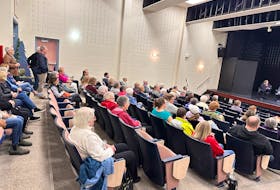With the 25th anniversary of Byron Carr’s murder fast approaching, police believe this cold case can — and will — be solved.
“We are confident we are going to be able to bring this to closure for the family,’’ Sgt. Brad MacConnell, the detective with the Charlottetown Police Services who has been leading a determined investigation since 2007, said Thursday.
“We think that we’re certainly on the playing field and it’s just a matter of time before we’re knocking on the door of the right person.’’
MacConnell says police have been able to advance a new theory and a new timeline for the events that led to the death of the popular 36-year-old gay teacher in his Charlottetown home on Nov. 11, 1988. Police now believe two people were involved.
CLICK HERE FOR A TIMELINE OF EVENTS ON THE DAYS AROUND BYRON CARR'S MURDER
MacConnell believes the killer acted alone in strangling Carr to death at his home following a sexual act. He also says a strong DNA profile believed to belong to the killer has been compiled from the crime scene.
Police have developed a profile of the killer being at the time of the crime between 15 and 25, likely bi-sexual, a resident of Charlottetown, and a person having had previous involvement with police.
Police still, however, do not know the person’s identity.
MacConnell, though, says police have been pursuing a strong lead that could eventually lead to the killer. Police have identified a person they are quite certain returned to the crime scene with the killer in an attempt to remove evidence.
CLICK HERE FOR A SLIDESHOW OF PHOTOS FROM CARR'S HOME
Two people have come forward stating this secondary person had confessed to this involvement. These people are not connected and these disclosures happened at different times, notes MacConnell.
The second witness, who came forward in 2012, provided information given from the secondary person that police feel “only someone involved in this crime would have known.’’
The secondary person, says MacConnell, was on a short list of suspects early in the investigation.
He was 27 at the time of the murder. A native of Charlottetown, he was believed to be bi-sexual and had a violent criminal history, including robberies of gay men. He had also recently been released from federal prison when Carr was murdered.
While the man died 10 years ago, he is still seen as a promising link to the killer, says MacConnell.
“What this has put us in a position to do is to create a short list of people — associates, family members of this secondary person — and conduct interviews with them to identify the primary,’’ he says.
The DNA believed to be the killer’s does not match with any other cold case or any person in the DNA databank.
MacConnell believes Carr was stabbed when the killer returned with the second man in an attempt to remove incriminating evidence.
The crime scene, notes MacConnell, showed signs of frustration on the part of the two men.
“They came for something and they can’t find it and what we are seeing is some juvenile behavior associated to that and a lot of frustration in these acts,’’ he says.
One of those acts, he notes, is a letter warning “I will kill again.’’ MacConnell says handwriting analysis suggests the letter was not written by the killer, but by his accessory after the fact.
MacConnell says he knew tackling the cold case would be challenging when he took the lead more than six years ago. He is pleased with the effort, and the results, to date.
“Since we began the cold case review back in 2007, we have conducted an extensive crime scene analysis of the evidence,’’ he says.
“We have interviewed hundreds of people. We have used advances in technology such as DNA analysis and the media to advance this investigation. All of that has allowed us to advance a new theory and a new timeline for the events that surrounded the death of Byron Carr.’’
The gay community, he adds, has also stepped forward to provide valuable information to police.
“When we made our plea to the gay community, it wasn’t necessarily because we believed somebody in the gay community was involved, it was more of the fact that we believed somebody else in the gay community may have had a bad encounter with this person (Carr’s killer) around this time period,’’ says MacConnell.
With the 25th anniversary of Byron Carr’s murder fast approaching, police believe this cold case can — and will — be solved.
“We are confident we are going to be able to bring this to closure for the family,’’ Sgt. Brad MacConnell, the detective with the Charlottetown Police Services who has been leading a determined investigation since 2007, said Thursday.
“We think that we’re certainly on the playing field and it’s just a matter of time before we’re knocking on the door of the right person.’’
MacConnell says police have been able to advance a new theory and a new timeline for the events that led to the death of the popular 36-year-old gay teacher in his Charlottetown home on Nov. 11, 1988. Police now believe two people were involved.
CLICK HERE FOR A TIMELINE OF EVENTS ON THE DAYS AROUND BYRON CARR'S MURDER
MacConnell believes the killer acted alone in strangling Carr to death at his home following a sexual act. He also says a strong DNA profile believed to belong to the killer has been compiled from the crime scene.
Police have developed a profile of the killer being at the time of the crime between 15 and 25, likely bi-sexual, a resident of Charlottetown, and a person having had previous involvement with police.
Police still, however, do not know the person’s identity.
MacConnell, though, says police have been pursuing a strong lead that could eventually lead to the killer. Police have identified a person they are quite certain returned to the crime scene with the killer in an attempt to remove evidence.
CLICK HERE FOR A SLIDESHOW OF PHOTOS FROM CARR'S HOME
Two people have come forward stating this secondary person had confessed to this involvement. These people are not connected and these disclosures happened at different times, notes MacConnell.
The second witness, who came forward in 2012, provided information given from the secondary person that police feel “only someone involved in this crime would have known.’’
The secondary person, says MacConnell, was on a short list of suspects early in the investigation.
He was 27 at the time of the murder. A native of Charlottetown, he was believed to be bi-sexual and had a violent criminal history, including robberies of gay men. He had also recently been released from federal prison when Carr was murdered.
While the man died 10 years ago, he is still seen as a promising link to the killer, says MacConnell.
“What this has put us in a position to do is to create a short list of people — associates, family members of this secondary person — and conduct interviews with them to identify the primary,’’ he says.
The DNA believed to be the killer’s does not match with any other cold case or any person in the DNA databank.
MacConnell believes Carr was stabbed when the killer returned with the second man in an attempt to remove incriminating evidence.
The crime scene, notes MacConnell, showed signs of frustration on the part of the two men.
“They came for something and they can’t find it and what we are seeing is some juvenile behavior associated to that and a lot of frustration in these acts,’’ he says.
One of those acts, he notes, is a letter warning “I will kill again.’’ MacConnell says handwriting analysis suggests the letter was not written by the killer, but by his accessory after the fact.
MacConnell says he knew tackling the cold case would be challenging when he took the lead more than six years ago. He is pleased with the effort, and the results, to date.
“Since we began the cold case review back in 2007, we have conducted an extensive crime scene analysis of the evidence,’’ he says.
“We have interviewed hundreds of people. We have used advances in technology such as DNA analysis and the media to advance this investigation. All of that has allowed us to advance a new theory and a new timeline for the events that surrounded the death of Byron Carr.’’
The gay community, he adds, has also stepped forward to provide valuable information to police.
“When we made our plea to the gay community, it wasn’t necessarily because we believed somebody in the gay community was involved, it was more of the fact that we believed somebody else in the gay community may have had a bad encounter with this person (Carr’s killer) around this time period,’’ says MacConnell.









